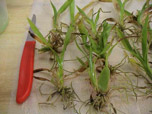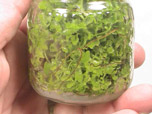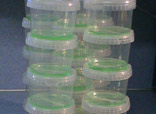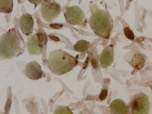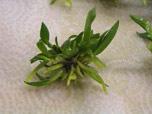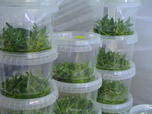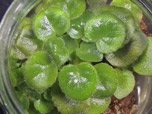Testimonials
Hildegard Crous, Specialist Horticulturist, Cape Institute of Micropropagation writes:
I hope this is not too elaborate. It is a rather long, sad story, but with a happy ending.
Two years ago I started noticing a contamination in many of my cultures. My first concern was that the media was not being adequately steralised, or that the culture containers were not sealing properly. Both these concerns were laid to rest, and on closer inspection I noticed that the contamination was entering the culture vessel via the plant material. (A week after replating, a white "cloud" would develop around the roots of the plants and increase steadily in size. Eventually it would surface and grow as layer on top of the media. On opening the culture vessel, a sickly, sour smell was evident.)
After replacing all the HEPA filters in the laminar flow bench, and ensuring new un-used steralised working surface for each replate, I started a rigorous rinsing programme of all the affected cultures. Many of the orchids I grow represent a genepool from as far back as 1996. I was anxious to not lose any if I could. New initiations were clean and were not becoming contaminated.
On replating, all plant material was rinsed in a solution of household bleach, (3,5%m/v), mixing 25ml bleach with 75ml water and adding another 5ml Dettol. After rinsing, the material was trimmed down, removing all outer layers. The plant material was then rinsed in a new solution mixed to the same strength as above and then given a final rinse in sterile water before being placed into a fresh culture vessel on new medium. This was done on average every 28 days, needless to say a very time consuming and costly excercise. In this way I managed to keep the contamination at bay, but I was steadily losing the battle. It is extremely demoralising to carry on desperately "cleaning" material, when you know its not going to work and that you will again be faced with the situation of either throwing out the material or trying to think of another method to stave off the contamination in order to rescue the plants. Although some of the plants continued to make offshoots, once these were harvested, they soon succumbed to the toxic effects of the contamination.
On two seperate occasions I sent a sample of the contamination to a pathology lab for identification, but in both cases nothing was forthcoming.
Although I was pretty sure that I had to do with a bacterial contamination, I was hesitant to apply antibiotics, as this can lead to mutation. Not much is known concerning the effect of antibiotics on disas (the orchids that I work with), and so I was hesitant to experiment with the material I was trying to save.
Somewhere in the depths of desperation I remember recieving a sample of PPM when I still worked in the tissue culture laboratory at Kirstenbosch Botanic Garden. I didn't have a need for it then, and therefore not tried it our, but on finding it on the internet I was intrigued by the accounts given by various people who had used it. I managed to obtain a 200ml sample from within South Africa. By this time I was desperate, and time was of the essence. I started incorporating it in all my media and started rinsing all my most desperate cases in the recommended PPM and citric acid solution. And then I waited. This was Dec 2005.
I am happy to say that I can now walk into my growth room with confidence and admire the lovely strong, green growth on all the plants. Although the contamination is still slightly visible on the larger, older plants, all the progeny that we are harvesting are culturing pure and clean. For some rhyme or reason the smaller the plant volume, the more effective PPM is. In the cases where the contamination was serious, I am finding that the contamination remains encased around the affected plant material and plants around it can be safely removed and cultured on.

